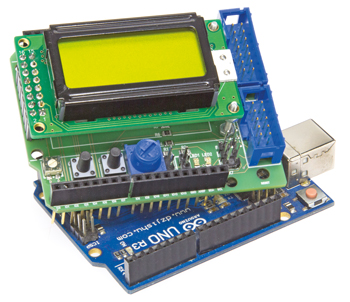Article
Arduino Experimenting Shield 2.0
Same functionality, better display options

In the 2014 July/August issue of Elektor we wrote about our Arduino Extension Shield that, in particular for the Arduino Uno, provided additional interface options, LEDs, pushbuttons and an LCD. The shield enjoyed — and continues to enjoy — a great deal of interest. Time for a makeover! The Arduino Experimenting Shield 2.0 offers largely the same features as its predecessor, but, after 3.5 years, quickly revisiting the specific details can do no harm.
Gerber file
CAM/CAD data for the PCB referred to in this article is available as a Gerber file. Elektor GREEN and GOLD members can exclusively download these files for free as part of their membership. Gerber files allow a PCB to be produced on an appropriate device available locally, or through an online PCB manufacturing service.
Elektor recommends the Elektor PCB Service service from its business partner Eurocircuits or AISLER as the best services for its own prototypes and volume production.
The use of our Gerber files is provided under a modified Creative Commons license. Creative Commons offers authors, scientists, educators and other creatives the freedom to handle their copyright in a more free way without losing their ownership.
PCB
Extra info / Update
2×8 character display
2 pushbuttons
1 potentiometer
2 indicator LEDs
Arduino expansion headers
ICSP header
Expansion headers for ECC- and EEC bus
2 pushbuttons
1 potentiometer
2 indicator LEDs
Arduino expansion headers
ICSP header
Expansion headers for ECC- and EEC bus
Component list
Component List
Resistors
R1,R2,R3,R4,R5 = 1kOhm
R6,R6 = 100Ohm
R8,R9 = 330Ohm
P1 = 10kOhm trimpot with turning knob
P2 = 10kOhm trimpot (SMD, Vishay TS53YJ103MR10)
Semiconductors
LED1,LED2 = low-current, red (0805)
LED3 = low-current, green (0805)
Miscellaneous
S1,S2 = pushbutton
K1 = 10-pin (2x5) boxheader, 0.1" pitch
K2 = 14-pin (2x7) boxheader, 0.1" pitch
K3,K6 = 8-pin pinheader, single row*
K4 = 10-pin pinheader, single row*
K5 = 6-pin pinheader, single row*
K7 = 6-pin (2x3) pinheader, 0.1" pitch
JP1,JP2 = 2-pin pin header, 0.1" pitch, with jumper
LCD1 = LCD 2x8 characters, with backlight, TC0802B
LCD1 = 16-pin (2x8) pinheader, 0.1" pitch
LCD1 = 16-way (2x8) socket for LCD1, 0.1" pitch
LCD1 = 4 off M2.5x20 metal screws
LCD1 = 12 off M2.5 bolts
PCB no. 160593-1 v2.1 [4] or
Ready-assembled module no. 140009-91 [4]
* K3–K6 = Arduino-shield pinheader
From the Store
160593-1 Bare printed circuit board
160593-91 Read-built module
Resistors
R1,R2,R3,R4,R5 = 1kOhm
R6,R6 = 100Ohm
R8,R9 = 330Ohm
P1 = 10kOhm trimpot with turning knob
P2 = 10kOhm trimpot (SMD, Vishay TS53YJ103MR10)
Semiconductors
LED1,LED2 = low-current, red (0805)
LED3 = low-current, green (0805)
Miscellaneous
S1,S2 = pushbutton
K1 = 10-pin (2x5) boxheader, 0.1" pitch
K2 = 14-pin (2x7) boxheader, 0.1" pitch
K3,K6 = 8-pin pinheader, single row*
K4 = 10-pin pinheader, single row*
K5 = 6-pin pinheader, single row*
K7 = 6-pin (2x3) pinheader, 0.1" pitch
JP1,JP2 = 2-pin pin header, 0.1" pitch, with jumper
LCD1 = LCD 2x8 characters, with backlight, TC0802B
LCD1 = 16-pin (2x8) pinheader, 0.1" pitch
LCD1 = 16-way (2x8) socket for LCD1, 0.1" pitch
LCD1 = 4 off M2.5x20 metal screws
LCD1 = 12 off M2.5 bolts
PCB no. 160593-1 v2.1 [4] or
Ready-assembled module no. 140009-91 [4]
* K3–K6 = Arduino-shield pinheader
From the Store
160593-1 Bare printed circuit board
160593-91 Read-built module


Discussion (0 comments)